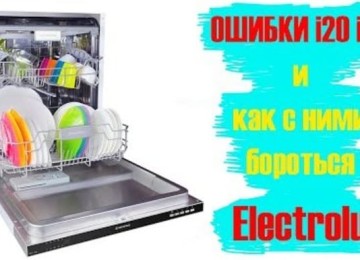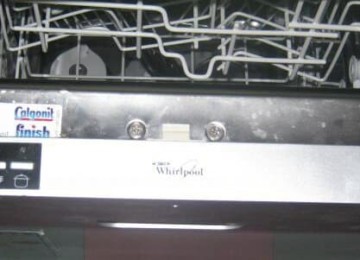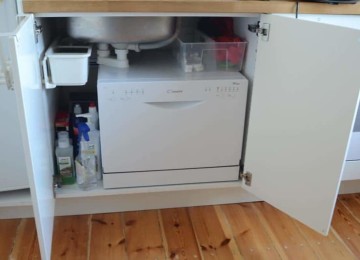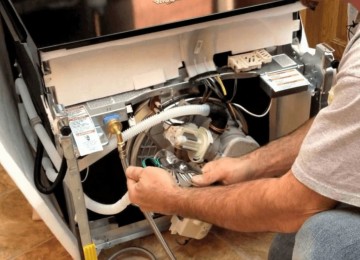The uninterrupted operation of equipment from German manufacturers is familiar to their owners, so the E15 error that appears on the screen on a Bosch dishwasher can confuse the user. The main thing is not to panic, figure out the cause and try to eliminate it.
Decoding error E15
This error indicates problems with drainage. The code is displayed when the AquaStop system is activated, which detects an increase in the permissible water level in the tank, problems with the drainage system or pump. “Aquastop” is a device designed to protect a consumer’s home from flooding. The bottom of the dishwasher is located at a slight angle. At the bottom there is a foam float, which, when liquid appears, floats up and presses the sensor. As a result, the drain pump turns on automatically.
Causes of error E15
There aren't many of them. The most common include:
- blockage of one of the elements of the sewer system (for example, a hose);
- violation of the tightness of the drain system;
- failure of the alarm device that detects a water spill;
- Problems with the rocker arm that sprays water onto the dishes.
In addition to the problems listed above, sometimes another one arises - the permitted amount of detergent used is exceeded.
In what cases can you fix error E15 yourself?
Not all possible problems require an urgent call to a technician; first you need to try to solve the problem yourself. This can be done in the following cases:
- Error in the software system. If the machine is new and has never been repaired, then the error may appear not only due to some kind of malfunction, but also due to a voltage drop. The solution is quite simple - reset the settings.
Each Bosch dishwasher model has its own reset algorithm. You should read this in the instructions that came with the machine.
The most universal and fastest way to resolve error E15 is to disconnect the device from the network and leave it turned off for at least 15 minutes. If error E15 is displayed again after a reset, try the following algorithm:
- open the machine door;
- hold down the buttons of the first and third programs for 4 seconds;
- close and then reopen the loading door;
- use the reset button, holding it for 4 seconds;
- Close the door again and wait for the program end signal.
If the previous methods did not work, then try holding down the power button and hold it for about 30 seconds.
- There is a leak in the pipes connected to the dishwasher. Check plumbing and drains for leaks. Maybe you recently accidentally spilled water on the countertop - this can also cause liquid to get into the pan and cause error E15 to appear. Get rid of the leak and the problem will go away.
- Using liquid for hand washing dishes.Some owners use regular products, such as Sorty or Fairy, instead of special powder and rinse aid for dishwashers. This leads to increased foam formation, which causes the error to appear.
When this happens, immediately turn off the dishwasher and unplug the power cord. Let it dry for two to three days. If the dishwasher does not work after this, it means that the electronics are flooded and repairs are necessary.
- Clogged. Due to contamination of the filters, water circulation is disrupted, which leads to overflow of the drainage systems and liquid getting into the tray. To solve the problem, you just need to clean the filters. By the way, the manufacturer recommends doing this after each dishwashing, as well as cleaning them from large food residues before loading them into the machine. Cases when it is better to call a specialist
However, if all the above recommendations do not work, you will need the help of a specialist, because the problem may be hidden in the control panel or something else, for example: 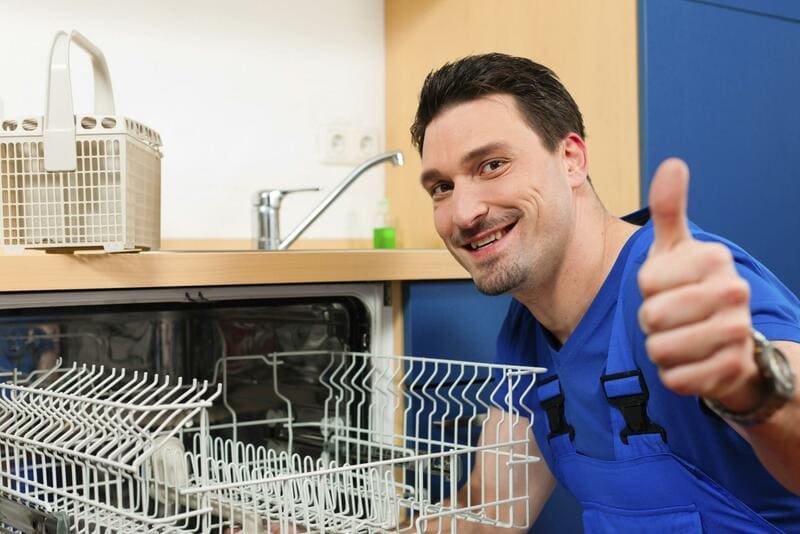
Leaky connections inside the dishwasher (pipes, hoses, pumps) are the most common cause of the error. The specialist must find out the location of the leak, tighten the clamps and replace the necessary parts.
- Corrosion on the surface of the tank. In rare cases, the tank of the dishwasher can crack, which will lead to the appearance of extra holes. This may be due to a manufacturing defect and is more common in older devices. The simplest solution is to seal the holes, but it is only temporary and can extend the service life of the machine for no more than a year.
- The door seal is worn out or damaged. For this reason, when washing, water flows onto the floor, and from there into the tray.Some owners, instead of special powder and rinse aid for dishwashers, use conventional products, for example, Sorty or Fairy. This leads to increased foam formation, which causes the error to appear.
- When this happens, immediately turn off the dishwasher and unplug the power cord. Let it dry for two to three days. If after this the dishwasher does not work, it means that the electronics are flooded, and repairs are no longer possible.
- Blockage. Due to contamination of the filters, water circulation is disrupted, which leads to overflow of the drain systems and liquid entering the pan. To solve the problem, you just need to clean the filters. By the way, the manufacturer recommends doing this after each dishwashing, and also clearing it of large food residues before loading it into the machine.
Cases when it is better to call a specialist
However, if all of the above recommendations do not work, you will need professional help because the problem may be hidden in the control panel or something else, for example:
- Leaky connections inside the dishwasher (pipes, hoses, pumps) are the most common cause of error. The technician must find out the location of the leak, tighten the clamps and replace the necessary parts.
Corrosion on the surface of the tank. In rare cases, the dishwasher tank may crack, causing extra holes. This may be due to a manufacturing defect and is more common in older appliances. The simplest solution is to seal the holes, but this is only temporary and can extend the life of the machine by no more than a year.
The door seal is worn or damaged. For this reason, when washing, water flows onto the floor, and from there into the tray.To solve the problem, you just need to replace the seal.
The salt container or heat exchanger cartridge is cracked. After rinsing, water still remains in the machine. If left in this state for a long time in a cold room, the water will freeze and the ice can rupture plastic containers and hoses. To solve the problem, you will have to replace all damaged elements.
- Do-it-yourself troubleshooting
- To correct some of the causes of the error yourself, you should follow a clear algorithm depending on the type of problem:
- Cleaning the filter. An inlet valve filter is installed to protect the equipment from dirt and debris from the water supply. If liquid is drawn into the dishwasher too slowly or does not flow at all, the most common cause is a clogged filter.
- The filter must be checked and cleaned regularly. This won't take much time, but it will save you from possible problems.
- Before cleaning, turn off the water supply. The filter is located at the bottom of the device - it is a cylindrical tube that is locked in place using twist locks. Depending on the model of your dishwasher, there may also be a secondary flat filter with a hole in the center through which the cylindrical part passes. You will need to remove them both for cleaning.
- Rotate the cylindrical filter to unlock it in the direction indicated by the arrows, then remove it. You can first wash the filter with warm soapy water, and then rinse it thoroughly under cold water. To remove food debris, scrub gently with a toothbrush and then with a sponge. You can use a damp towel to remove any remaining debris.When finished, reinstall the cleaned filter and connect the hose.
- Replacing the drain hose and pipes. To replace or clean the drain hose, you will need to disassemble the dishwasher body. An approximate sequence of actions can be represented as follows:
- disconnect the equipment from the power supply and turn off the water supply tap;
- install the machine so that you have access to its bottom;
- remove the fasteners, holding the lower part of the machine (the main thing is not to completely remove the cover, since a float is attached to the back of it);
open the lid slightly and unscrew the screw securing the float sensor (so that it can be replaced if it breaks);
remove the side cover and inspect the hose and pump connections;
- disconnect the hose from the pump using pliers;
inspect the hose for blockages, if necessary, clean it with a stream of water or replace it;
turn off the pump by disconnecting the clamps securing it and the side screw;
Remove the pump and inspect the gasket and impeller for damage.
- A faulty pump cannot be repaired and must be replaced. When installing a new part, the above steps are performed in reverse order.
- When disassembling the dishwasher body according to the described scheme, it is recommended to simultaneously inspect the pipes. If the fastening is weak, buy new cable ties and tighten the parts tightly. If you notice damage to one of the injectors, replace it with a new one.
- Replacement of leakage sensor and sprinkler. Another reason for water flow may be a faulty leak sensor. This is extremely rare, but if the sensor is faulty, it may operate when there is no water in the tray and not turn on when a leak occurs.The sensor is located on a plastic cup at the bottom of the device and must be replaced if faulty.
- The sprinklers in the machine are replaceable, so you can replace them in a few movements. To do this, remove the dryer, press down on the sprayer holder with a screwdriver and pull it out. The new part is installed until it clicks. The procedure for replacing the upper impeller is the same.
- Prevention of dishwasher breakdowns
- Any equipment, including a dishwasher, may not work correctly. This is due to both software errors and technical failures. To prevent most of these problems, the user should perform regular maintenance, which includes the following steps:
- always check the inlet water temperature to ensure it does not exceed 60°C;
monitor the amount of rinse aid in the dishwasher and avoid running out of it;






